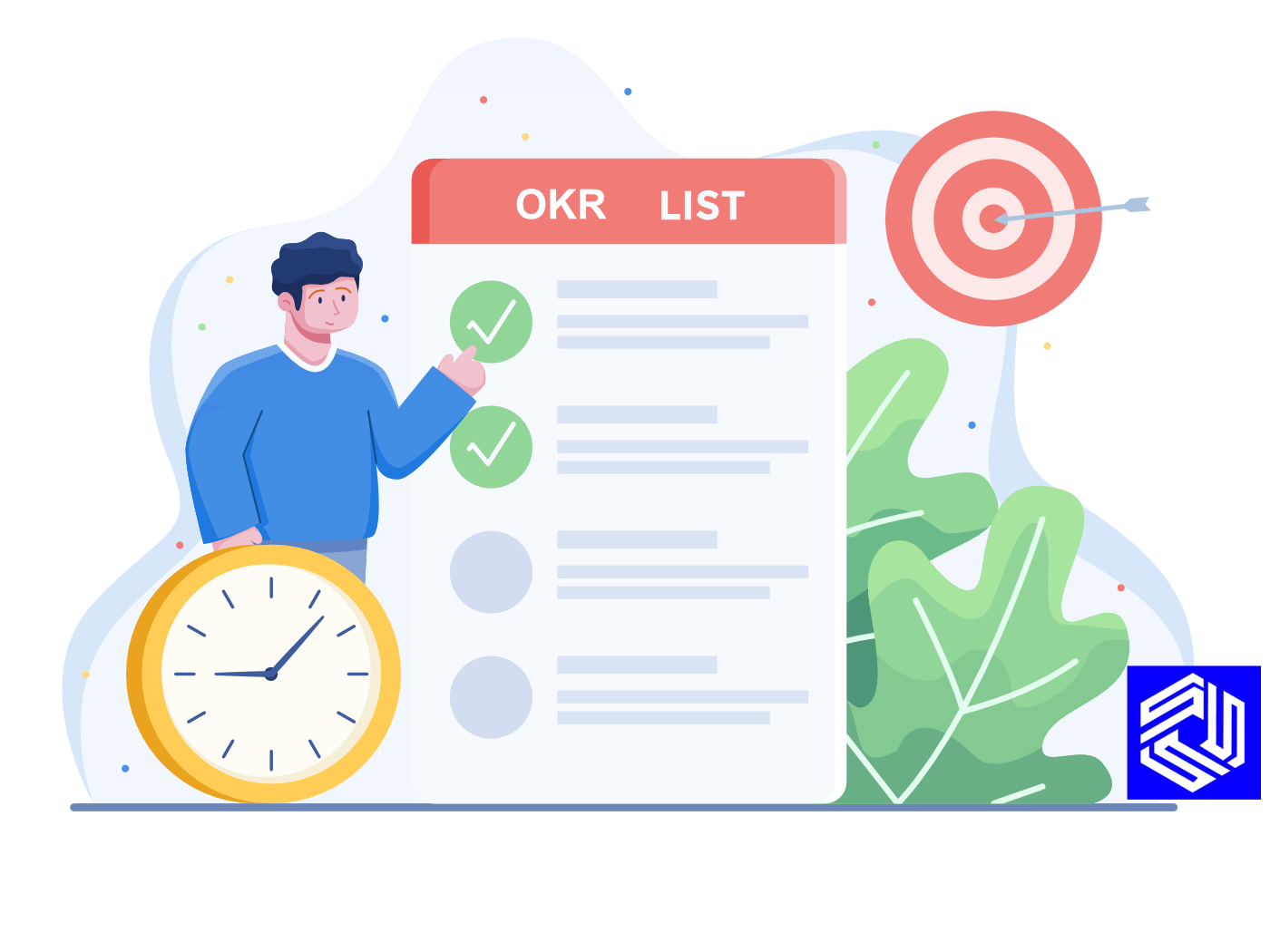20 Examples of OKRs For A Small Business
Are you a small business owner looking for a way to increase your team's performance and drive better results? Look no further than OKRs (Objectives and Key Results).
OKRs are a powerful, simple framework to set and track progress on your team's goals. They can help you focus, align, and motivate your employees to achieve your business objectives. In this blog, we'll cover the basics of OKRs and how a small business can use them to succeed.
We'll discuss what OKRs are, why they're important, and how to create effective OKRs. We'll also provide some tips and best practices for getting the most out of your OKRs. So, let's get started and learn how OKRs can help your small business reach its goals!

What are OKRs?
OKRs (Objectives and Key Results) are a goal-setting (okr framework) used to establish a small business's mission and a set of measurable objectives.. It is designed to help individuals and teams set ambitious, measurable goals and measure progress against them. OKRs consist of an Objective, which outlines the overall goal, and 3-5 Key Results, which are specific, measurable outcomes that need to be achieved in order to reach the Objective.
Okrs are an important way for businesses to track and measure their progress towards goals. For small businesses, okrs can help focus on the most important tasks and ensure that resources are being used to their fullest potential.
A good set of OKRs is simple enough that everyone in the organization can understand it, but detailed enough that it is challenging to achieve. It is a useful tool to increase focus and employee engagement.
Why use OKRs for a small business: Benefits of OKRs
OKRs (Objectives and Key Results) can be a valuable tool for small businesses to help set and measure goals, foster collaboration, and create a culture of accountability. OKRs are also a useful tool for aligning the goals of the entire organization with the higher-level goals of the business. By using OKRs, small businesses can stay focused on their core objectives and ensure that everyone in the organization is working together to achieve them. Other benefits of using OKRs are:
- Improved Focus: OKRs give employees and teams a clear direction to focus on, ensuring that everyone is aligned and working towards the same objectives.
- Improved Accountability: By setting measurable objectives and key results, OKRs give team members a clear understanding of what is expected of them, helping to keep them accountable for their work.
- Increased Visibility: OKRs give managers and executives visibility into the progress of their teams and projects, helping them to make more informed decisions.
- Increased Motivation: By setting achievable goals and celebrating when they’re achieved, OKRs can help to increase motivation and engagement in the workplace.
- Faster Results: By setting tangible, measurable goals, OKRs can help teams to focus on the things that really matter, leading to faster results and more successful projects.
Set up OKRs For a Small Business
Here are some tips for setting up OKRs for a small business:
Identify the most important objectives for the business: Start by deciding on the most important objectives for your business. Consider factors such as your company goals, the vision of the business, and any current challenges.
Establish measurable goals: Establish goals that are specific, measurable, and achievable. Think about what success looks like, and how you can measure it.
Set up a system to track progress: This could be a spreadsheet, project management software, OKR software, or even a whiteboard.
Assign ownership: The best way to do this is to first identify the key areas of focus for your business, and then match these areas to the skills and strengths of your team members. When assigning OKRs, be sure to consider the workload of each individual and team, and distribute the objectives fairly. It's also important to clearly communicate the expectations for each objective, so that everyone is on the same page.
Establish your timeline: Establish a timeline for implementation and completion of your OKRs. This will help you stay on track and ensure that your OKRs remain relevant. This could be a quarter, a year, or any other time period that works for your business.
Set measurable objectives: Determine what you want to achieve and how you plan to measure success. This can include anything from increasing revenue, reducing costs, or improving customer satisfaction.
Create key results: Create key results that are measurable, attainable, and time-bound. These should be specific, actionable steps that will help you reach your objectives.
Monitor progress: Monitor progress on a regular basis to ensure that your OKRs are being met. This will help you adjust your strategy as needed and make sure you stay on track.

High Level OKRs Examples
At a high level, OKRs are used to align an organization around a set of objectives and key results that will help it achieve its overall mission. Some okrs are:
Overall company strategy OKR
Company strategy OKRs are objectives and key results that a company sets to accomplish specific goals and objectives. The main purpose of company strategy OKRs is to help guide and align the efforts of all employees towards the same end goal. This could make it easy to come up an employee satisfaction score. Company strategy OKRs should be regularly reviewed and updated as the company’s objectives and priorities change. They should also be set in a way that allows for employees to easily understand and track progress against them.
HR OKR Examples
HR OKR stands for Human Resources Objectives & Key Results. It is a goal-setting framework used by HR departments to measure progress and alignment with organizational goals. HR OKR includes setting objectives (long-term goals) and key results (measurable outcomes that demonstrate progress towards the objectives). It is an effective way to drive ongoing performance management process and ensure that HR initiatives are aligned with the company's overall mission and objectives.
Marketing OKR Examples
Marketing OKRs (Objectives & Key Results) are a goal-setting tool used by a marketing team to conduct market research, set and track progress towards specific objectives. OKRs are set using a specific format consisting of an objective (what needs to be achieved) and several key results (how success will be measured). The key results should be measurable and tracked to ensure progress is being made towards the objective. This helps marketing teams stay organized and focused on their goals and objectives, helping to maximize the efficiency and effectiveness of their efforts.
Customer Delivery OKRs or Service OKRs
Customer Delivery OKRs are goals set to measure the success of customer service teams and how well they are meeting customer needs. They typically focus on specific metrics such as customer satisfaction, customer retention, customer loyalty, customer lifetime value, and customer acquisition. Service OKRs are also set to measure the performance of customer service team members and how well they are providing customer service. They typically focus on metrics such as response time, resolution time, customer support quality, customer feedback, customer experience and implement scalable customer support process.
Sales OKR Examples
Sales OKRs are performance objectives that are set by organizations to measure and track their progress in achieving their company global sales target. They are established to provide a framework for the sales team and help them focus on the most important goals and objectives. They typically include measurable targets for each key result, such as revenue, customer satisfaction, and market share. By setting specific and measurable objectives, Sales OKRs help marketing and sales teams measure and track progress (sales pipeline), identify areas of improvement, and ensure that everyone is on the same page.
Product Management Goals
Product Management Goals are the objectives that a product management team will strive to achieve in order to ensure the success of their product. Goals typically include increasing the value of the product to customers, improving the customer experience, enhancing the usability of the product, and ensuring the product meets the needs of the market. These goals are typically supported by strategies such as improving the product design, developing a marketing plan, building a customer community strategy, and creating a roadmap to success. Product Management Goals should always be aligned with the overall business strategy, so that the product can help the company achieve its overall goals.
20 Examples of OKRs for a small businesses
OKRs are particularly useful for small businesses, as they provide focus and direction to operations, and help ensure that everyone is working towards the same goals. We have listed 20 best OKR examples but explained in great detail only 10 of them.

The first 10 OKR examples include:
#1. Increase Website Traffic
An OKR (Objective and Key Results) to increase website traffic would involve setting an objective of increasing visits to the website by a certain percentage within a certain timeframe. This would be accompanied by key results to measure progress towards the objective such as increasing the number of visits, increasing the time spent on the website, and improving the conversion rate of visitors to customers. Additionally, the OKR should include measurable goals for metrics such as number of backlinks, organic search traffic, and social media followers. This OKR should include activities that will help to achieve the desired result such as optimizing website content, improving search engine optimisation, developing and executing a content strategy, and running social media campaigns.
Example:
- Objective: Increase website traffic by 20% in 3 months.
- Key Results:
- Increase organic website traffic by 10% in 3 months.
- Increase referral website traffic by 10% in 3 months.
- Increase average time on page by 10% in 3 months.
- Increase page views per session by 10% in 3 months.
- Increase conversion rate by 5% in 3 months.
#2. Increase Sales Conversion Rate
In the case of increasing sales conversion rate, the objective would be to increase the rate at which prospects convert into customers. The key results would be to measure the current conversion rate, develop strategies to improve it, implement those strategies, and measure the improvement in the conversion rate. The team would then adjust those strategies accordingly in order to reach the desired conversion rate. By setting OKRs, the team has a clear goal to strive to and can measure their progress.
Example:
- Objective: Increase sales conversion rate by 15% in 3 months
- Key Results:
- Increase organic search traffic by 10%
- Increase website conversion rate by 10%
- Increase time on page by 10%
- Increase CTR on emails by 10%
- Increase sales conversion rate by 15%

#3. Increase Revenue
The purpose of setting an OKR for increasing revenue is to create a measurable goal that can be used to track progress and determine if objectives are achieved. The objective would be to increase revenue by a certain percentage, and the key results would be milestones that need to be achieved in order to reach this goal. These key results could include increasing the number of leads, improving sales processes, increasing customer retention rates, and optimising pricing. By tracking the progress of each of these key results, the team can make sure they are on track to achieving their revenue goals.
Example:
- Objective: Increase Revenue
- Key Results:
- Increase sales by 10%
- Increase customer satisfaction by 20%
- Reduce customer acquisition costs by 5%
- Generate 3 new revenue streams
#4. Increase Lead Generation
An OKR to increase lead generation would involve setting an objective of increasing leads by a certain percentage over a specific period of time. With an OKR in place, teams can focus on specific goals to ensure lead generation growth.
Example:
- Objective: Increase Lead Generation
- Key Result: Generate 500 qualified leads per week.
#5. Increase Customer Retention Rate
This involves actively engaging with customers and building relationships with them. It requires companies to analyze customer data, identify customer needs, and develop strategies to meet those needs. Companies can use loyalty programs, personalized promotions, customer feedback surveys, and other engagement tactics to build relationships with customers and reward them for their loyalty. It's important to focus on customer satisfaction and providing excellent customer service to retain customers.
Example:
- Objective: Increase customer retention rate by 10%
- Key Result: Increase customer satisfaction score from 4.2 to 4.5 by end of the quarter
#6. Improve Quality of Customer Service
Improving the quality of customer service means providing customers with timely, efficient and helpful service that meets or exceeds their expectations. Companies can achieve this by developing customer service standards, training employees to be knowledgeable and courteous, having a customer feedback system, and following up on customer complaints.
Example:
- Objective: Improve quality of customer service
- Key Result: Increase customer satisfaction rating to 95%
#7. Increase Brand Awareness
Increasing brand awareness involves making potential customers aware of a brand and its offerings. This can be done through various marketing strategies, such as advertising, influencer marketing, content marketing, and social media campaigns. Companies can also use search engine optimization (SEO) and pay-per-click (PPC) marketing to ensure that their websites are visible in organic and paid search engine rankings. Brand awareness also involves building relationships with customers through customer service, loyalty programs, and public relations to ensure customer success. In short, increasing brand awareness is essential for any business to reach potential customers and establish a strong presence in the market.
Example:
- Objective: Increase Brand Awareness
- Key Result: Increase the number of followers on social media by 50%
#8. Increase Engagement on Social Media
Increasing engagement on social media means creating content and activities that encourage users to interact with and share it. This could include creating interesting visuals, running polls and contests, and responding to comments and questions. By interacting with followers, businesses can build relationships and loyalty, as well as drive more traffic to their website and other online platforms. When done strategically, increasing engagement on social media can help build a community, promote brand awareness, and increase sales.
- Objective: Increase engagement on social media by 10%
- Key Results:
- Increase average post interactions (likes, comments, shares, etc.) by 10%
- Increase average post reach by 10%
- Increase average post clicks by 10%
- Increase average post impressions by 10%
- Increase average post views by 10%
#9. Increase Number of Referrals
Increasing the number of referrals means increasing the amount of people that are referring new customers to a business. This can be accomplished by utilizing a variety of methods such as offering incentives for referrals, making referral programs more visible, and increasing the quality of customer service. By doing so, businesses can build relationships with existing customers, gain more exposure, and generate more revenue.
- Objective: Increase the number of referrals for our products by 10% within the quarter.
- Key Results:
- Increase the number of referrals from existing customers by 15% within the quarter.
- Increase the number of referrals from new customers by 10% within the quarter.
- Increase the number of referrals through social media platforms by 5% within the quarter.
- Increase the number of referrals through email campaigns by 10% within the quarter.
- Increase the number of referrals through referral program sign-ups by 10% within the next quarter.

#10. Decrease Cost Per Acquisition
Decrease Cost Per Acquisition (CPA) is a measure of how much it costs to acquire a new customer or convert a prospect into a paying customer. This metric is important to track because it helps businesses understand the efficiency of their marketing and sales efforts, as well as their overall customer acquisition cost. A lower CPA indicates that the company is able to acquire customers at a lower cost, resulting in higher profits. CPA can be improved by optimizing marketing campaigns, targeting the right audience, and focusing on customer retention.
An OKR for Decreasing Cost Per Acquisition could be:
- Objective: Reduce Cost Per Acquisition by 20%
- Key Results:
- Increase the total number of leads by 10%.
- Decrease the amount spent on paid advertising by 15%.
- Increase conversion rate from leads to customers by 5%.
- Increase customer loyalty and retention by 10%.
BONUS: Increase Number of Subscribers
Increasing the number of subscribers means increasing the number of people who are actively interested in your content or products. This can be done by providing interesting and engaging content, offering incentives, such as discounts or freebies, and by increasing visibility through social media and other marketing strategies. It is important to focus on providing value to your subscribers rather than just trying to increase the numbers, as this will ensure that your subscribers stay engaged and keep coming back for more.
An OKR for increasing the number of subscribers would involve setting an ambitious, measurable goal for the number of subscribers that should be acquired within a certain time period.
- Objective: Increase the Number of Subscribers
- Key Result:
- Increase the number of email subscribers by 10% by the end of Q2.
- Increase the number of social media followers by 15% by the end of Q2.
- Increase the number of paid subscribers by 20% by the end of Q2.
Extra OKR Examples
- Increase Market Share
- Maximize Profitability
- Decrease Expenses
- Develop New Skills and Knowledge
- Reach Out to New Markets
- Generate More Press
- Launch a New Website
- Launch a New Product
- Increase Employee Retention
- Increase Brand Loyalty
Skhokho OKR Software
Skhokho offers the best OKR software for small business. Skhokho OKR App help your organisation get closer to achieving its goals, in a collaborative, intelligent and effective way, guaranteeing your desired outcome.

You can complete the following actions on the Skhokho OKR App:
- Team Collaboration: Invite your team to collaborate on the app. All the members are connected in one space with the ability to view all the objectives and key results with strict access control.
- Set Objectives: You can set high level objectives as described in the point above. Each objective will have a title, description and responsible person. In addition you can include the start and due date for the objective to assist with time-tracking of the progress when you set the Key Results.
- Set Key Results: you can then set Key Results connected to the objectives created above. Each key result also has a topic, description and responsible person. Start and due dates are also included. The app allows for max 5 Key results per objective as is in OKR best practice.
- Set Key Results Measurements: You can update the Key Results regularly with measurements on performance and report on the latest measures. You can attach supporting documentation as well to your Key Results.
- Reporting: Skhokho allows you to output PDF reports on the Objectives and Key Results separately in a format that can be shared with any interested parties.
- Analytics: View progress on OKRs in the OKR dashboard
- OKR Tasks: Create tasks for your team to work on achieving the Key Results. See your tasks in a Task Board and get daily reminders on tasks when they are due.
The best part is that The OKR App is included in the basic package for Skhokho together with the Human Resources and Manager Apps. The pricing can be found on the pricing page. Do not worry, they also offer a free 14 day free trial, no credit card information needed.
To get started click here to register your account. For more information on how to use Skhokho, click here.









